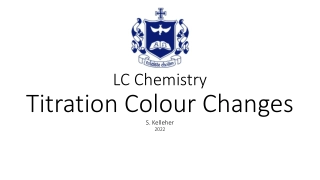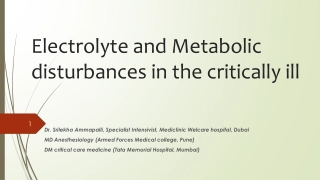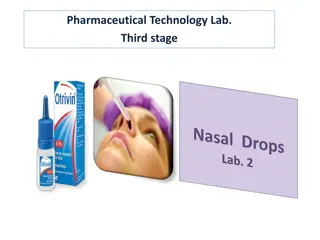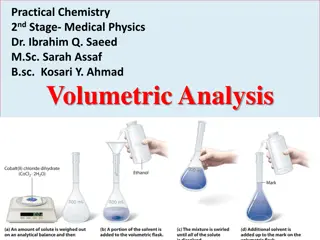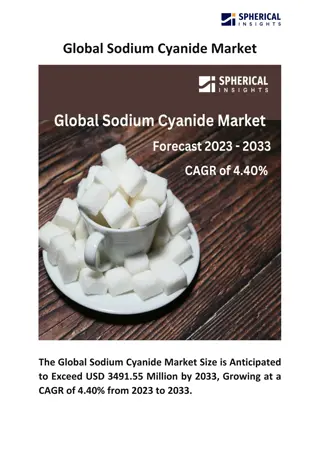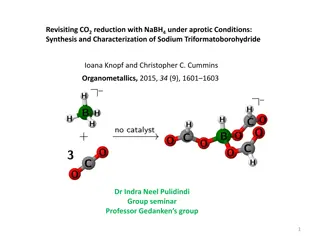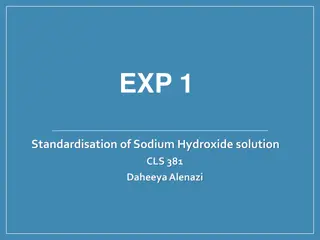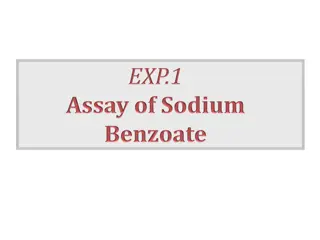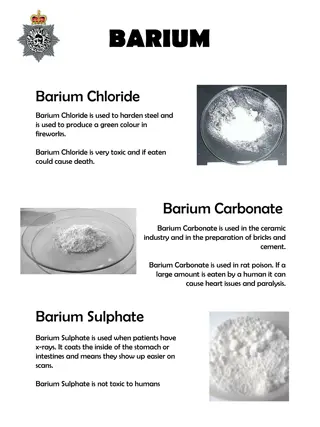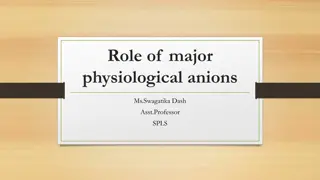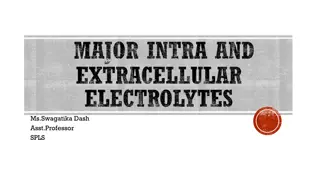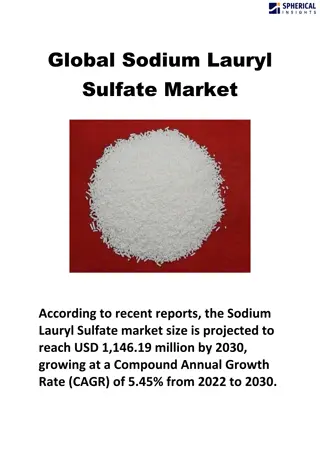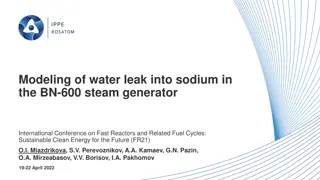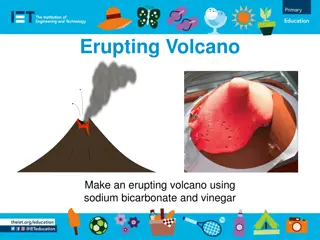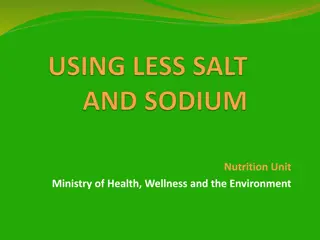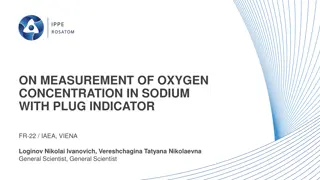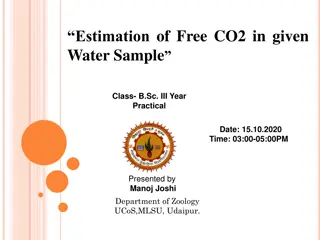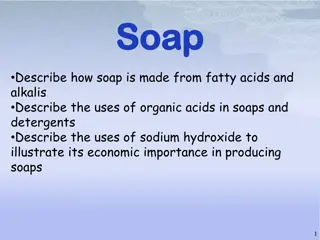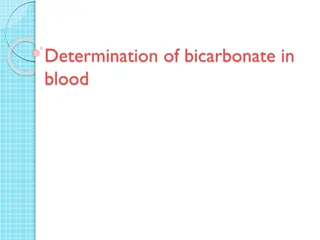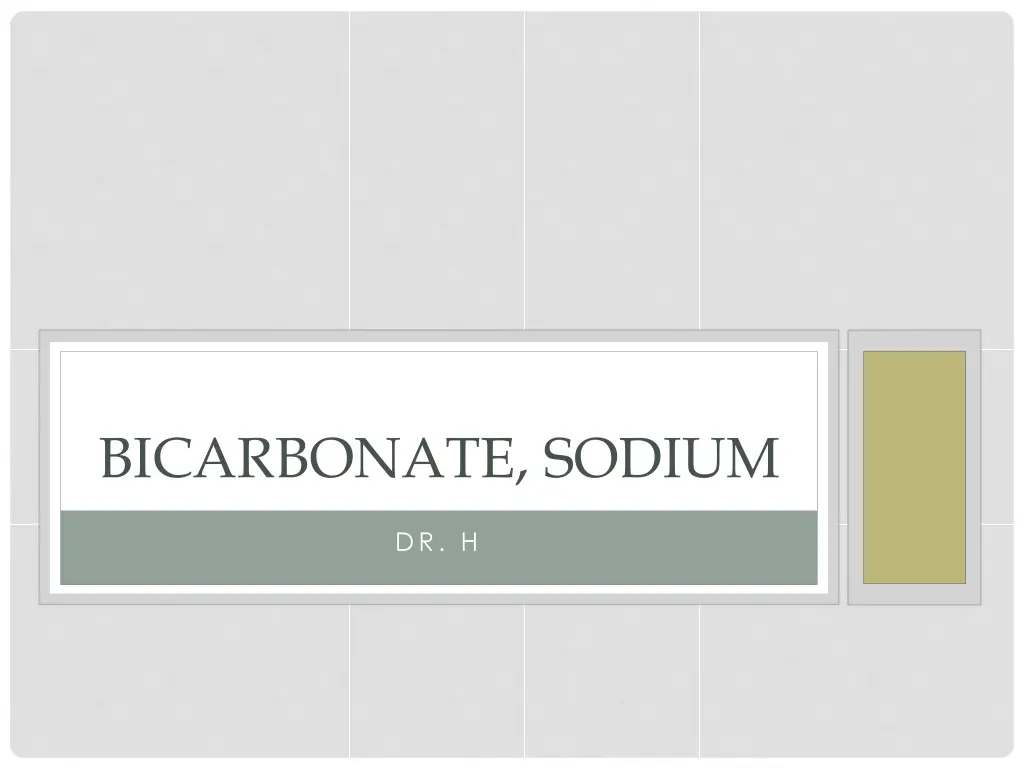
Understanding the Pharmacology of Sodium Bicarbonate for Acidemia and Alkalinization
Explore the pharmacological aspects of sodium bicarbonate, its uses in metabolic acidemia, urinary alkalinization, and cardiotoxic drug intoxication. Learn about its formulations, buffering properties, and applications in treating conditions like heartburn and chronic metabolic acidosis.
Download Presentation

Please find below an Image/Link to download the presentation.
The content on the website is provided AS IS for your information and personal use only. It may not be sold, licensed, or shared on other websites without obtaining consent from the author. If you encounter any issues during the download, it is possible that the publisher has removed the file from their server.
You are allowed to download the files provided on this website for personal or commercial use, subject to the condition that they are used lawfully. All files are the property of their respective owners.
The content on the website is provided AS IS for your information and personal use only. It may not be sold, licensed, or shared on other websites without obtaining consent from the author.
E N D
Presentation Transcript
BICARBONATE, SODIUM DR. H
OBJECTIVES Pharmacology Metabolic Acidemia Urinary Alkalinization Cardiotoxic drug intoxication ?Hyperkalemia Fun with Bicarb
PHARMACOLOGY Saleratus Latin for aerated salt aka baking soda, bread soda, and bicarb Nahcolite Natural mineral form Found in bile which neutralizes HCl from stomach
PHARMACOLOGY Prepared by the Solvay process CaCO3, NaCl, NH4 & CO2 in H2O Sea salt, Ammonia, Carbonic acid First developed by two New York Bakers in 1846 John Dwight & Austin Church
PHARMACOLOGY Buffering agent Reacts with hydrogen ions producing alkalosis Can improve myocardial contractility Sodium ion load + alkalemia reverses the sodium-channel- dependent membrane-depressant Alkalinization causes an intracellular shift of potassium
PHARMACOLOGY Formulations 4.2% (0.5mEq/mL) neonates/young children 7.5% (0.89 mEq/mL) volume of 10-500mL 8.4% (1mEq/mL) volume of 10-500mL Most common form is 8.4% (1mEq/mL) volume of 50mL
HEARTBURN 325-1300mg po q4h prn Max 15.6g/day Alt: tsp pwdr in 4oz water po q2h Duration: not longer than 2 wk
CHRONIC METABOLIC ACIDOSIS RENAL TUBULAR ACIDOSIS Type II (proximal) Decreased absorption of HCO3 in the proximal tubule 5-10mEq/kg/day po (div q4-6h) Seen in: Fanconi s Amyloidosis Multiple Myeloma Acetazolamide use
CHRONIC METABOLIC ACIDOSIS RENAL TUBULAR ACIDOSIS Type I (Distal) Defective H pump (in distal tubule) 0.5-2mEq/kg/day po (div q4-6h) Seen in: Sjogren s, SLE, Hepatitis, Nephrocalcinosis, Amphotericin, MM
CHRONIC METABOLIC ACIDOSIS RENAL FAILURE 20-36 mEq/day po div q4-6h Dose adjusted per serum bicarbonate levels
ACUTE METABOLIC ACIDOSIS SHOCK STATE The body works better in an acidemic environment Correcting pH with bicarbonate can lead to: Fluid overload Exacerbation of pulmonary edema Intracellular hypercapnic acidosis Decreases oxygen delivery Glucose metabolism Driving further lactic production Hypokalemia Decreases ionized calcium Decreasing cellular contraction / Hypocalcemic tetany
ACUTE METABOLIC ACIDOSIS LACTIC ACIDOSIS Typically made into gtt form (3amps in D5W = 150mEq NaHCO3) i.e. addition of bicarb into maintenance fluid Use is controversial as no studies have shown that correcting numbers improves survival General consensus: Use when pH < 6.9 as many other drugs in this setting will not work (especially pressor agents) Goal pH 7.2 Do not use when pH > 7.0 Consider in patients with AKI and inability for kidney to participate in acid-base balance
CASE #1 4 y/o old female presents with: CC: Lethargy x1 day ROS: Persistent vomiting PE: Afebrile, 120, 112/62, 60, 100%RA Obtunded PERRL CTAB NSR nlS1S2 +BS. Soft. ND nl muscle tone
CASE #1 CT scan: nl 7.19/16/110/6.2 145 / 116 / 5 ------------------ 24 4.2 / 6 / 0.3 Serum OSM 309 Urine pH 5, neg glucose, neg ketones
CASE #1 AG 23 MUDPILES OSM GAP 16 Pt given: Glucose IVF (NS) Bicarb gtt in D5W Fomepizole
CASE #1 Grandfather had accidentally left a bottle of antifreeze open in the garage and had the child playing in there while working on a car Child did well, discharged home 1 week later
ACUTE METABOLIC ACIDOSIS TOXIC INGESTIONS 0.5-1.0 mEq/kg IV bolus; repeat prn for goal pH 7.2 For salicylates, methanol, ethylene glycol, raise pH to 7.4 Corrects acidosis Inhibits precipitation of calcium oxalate in renal tubules Enhances elimination of glycolate & formate Ethylene glycol Glyceraldehyde Methanol Formaldehyde Formic Acid Glycolate
CASE #2 70 y/o AAM presents with CC: generalized weakness and slurred speech x1 day ROS: Tired. Denies HA, SOB, CP, n/v/d/c PE: 36.4; 67; 129/60; 20 Somnolent CTAB NSR nl S1S2 +BS, Soft, NT, ND No c/c/e Oriented x1, paranoid. PERRL. EOMI. No facial asymmetry. CN II-XII intact. Mvmts appear symmetric. Withdrawals appropriately
CASE #2 PMH HTN, DM, HCV, CVA, CAD h/o cath s/p stent, HL, PVD PSH Lap chole, ORIF for MVA MEDS Altace 10mg qd, Pletal 100mg BID, Metformin 500mg BID, Lipitor 20mg qHS, ASA 325mg qd SH Resides with wife. No EtOH. Tob 1ppd x 30 yrs FH NC
CASE #2 CT head with periventricular white matter disease, remote infarct in right side of pons, no hemorrhage, moderate atrophy 7.44/21/101/14 (RA) \ 10.5 / 6.3 ------ 400 140 / 110 / 32 -------------------- 82 3.6 / 15 / 1.5 UA: Pos ketones CE neg
CASE #2 AG 15 MUDPILES Salicylate level 61 (nl 2-29) Pt given: 2 amps HCO3 HCO3 gtt started (with K added in D5W) Serial ABGs, lytes and urine pH (goal urine pH >7.5)
CASE #2 Once mental status improved. Pt stated he had been taking 5-6 aspirins per day. He was unsure why he was taking it. Discharged in good condition.
URINARY ALKALINIZATION Useful in aiding excretion of: Salicyate, phenobarbital, chlorpropamide, chlorophenoxy herbicides Prevents nephrotoxicity from: Methotrexate precipitation Radiation acute tubular necrosis
URINARY ALKALINIZATION SALICYLATE POISONING 44-100mEq in 1L of 5% dextrose in 0.25% NS 88-150mEq in 1L of 5% dextrose at 2-3mL/kg/h (adults 150-200mL/h) Goal urine pH 7-8.5 / (keep blood pH <7.55) (monitor hourly) Hypokalemia & Hypovolemia prevent effective alkalinization Add 20-40mEq of K to each liter (unless there is renal failure) Urinary excretion is more dependent upon urine pH than renal flow rate trapping salicylates in urine and serum (increasing excretion and decreasing further redistribution)
CARDIOTOXICITY Prolonged QRS interval, >0.1 sec (or R wave >3mm in AvR) Wide complex tachycardia Hypotension Seizure activity Caused by: TCAs, Ia&Ic antiarrhythmics 1-2mEq/kg IV bolus over 1-2 minutes, repeat prn Goal pH 7.5 Corrects sodium channel blockade Improves cardiac contractility (by decreasing acidosis) Reverses acidic environment in which TCA toxicity thrives
HYPERKALEMIA Caused by: Transcellular shifts Acidosis, -blockers, Insulin Def, Dig, K-periodic paralysis Renal Insufficiency GFR nl GFR ( renin, aldosterone production, tubular response to ald) 1-3 amps IV Onset of action 15-30 minutes Transiently shifts K into cells (in exchange for H) MUST ACTUALLY MAKE BLOOD pH ALKALOTIC
ALTERNATIVES THAM Tris-hydroxymethyl aminomethane Diffuses into intracellular space Does not result in PaCO2 elevation Further studies still needed for worrisome features Hepatic failure Hyperkalemia Hypoglycemia Localized skin necrosis
ALTERNATIVES CarbiCarb Raised pH 3x greater than Bicarb Does not increase lactate Can lead to fluid overload and Hypokalemia Na2CO3 0.33 molar NaHCO3 0.33 molar 666mmol/L of HCO3- ions, and 1000mmol/L of Na+ions
THE ORIGINAL ODOR EATER Open a box and stick it in the fridge Deodorize Car Closet Drawers Cupboards Drain (two Tbs of bakind soda and then pour in a cup of vinegar have your kids do this!)
CLEANSER Ceramics Wet tub or sink, etc Sprinkle baking soda liberally Scrub until pretty Carpet Especially useful for animal messes Sprinkle on carpet Rub in Vacuum off (test an area of carpet beforehand to ensure you don t ruin the carpet)
FOR KIDS Volcano Jumping objects Clay 2 cups of baking soda 1 cup of cornstarch 1 cups cold water Food coloring Mix powders in a saucepan, add water and cook over medium heat for 10-15 min (stir constantly). Add food coloring. Once you ve made mashed potatoes remove from heat and place on plate. Mold into desired object (frame, handprint, etc), let dry overnight
INVISIBLE INK Mix bicarb with water Write on paper Reveal the hidden note with Heat Grape juice
NAHCO3, NOT JUST FOR THE FRIDGE Tendonitis for three straight nights before you go to bed, mix one teaspoon of baking soda per 100 pounds of your body weight into some water and drink it. Too much urate can force acid salts to deposit in joints and keep tendons inflamed Decreasing the acid levels may decrease inflammation I d avoid red meet and beer for a while, too
BAKING THE MOST APPROPRIATE USE OF BICARB!
REFERENCES Arm&Hammer Baking Soda. The Magic Of Arm & Hammer Baking Soda. Armhammer.com. Dzierba, A., etal. A Practical Approach to Understanding Acid-Base Abnormalities in Critical Illness. J of Pharm Practice. 2011. 24(1) 17-26 Hodgson, E.,etal. A Textbook of Modern Toxicology. Prentice Hall. 1997. Glisson, J., etal. Current Management of Salicylate-Induced Pulmonary Edema. S Med J. Mar2011. 104(3). 225-232 Kaspriske, R. Baking Soda s Not Just For The Fridge. Golf Digest; Mar2011 62(3). 63-1 Kimmoun, A. etal. Hemodynamic consequences of severe lactic acidosis in shock states: from bend to bedside. Critical Care. 2016. 19(175) Lam, S., etal. Toxicology Today: What You Need to Know Now. J of Pharm Practice. 2011. 24(2) 174-188 Rehm, M., etal. Treating Intraoperative Hyperchloremic Acidosis with Sodium Bicarbonate or Tris-Hydroxymethyl Aminomethanes: A Randomized Prospective Study. Anes & Analg. 96(4), 2003. 1201-1208. Sirieix, D, etal. Triis-hydroxymethyl aminomethane and sodium bicarbonate to buffer metabolic acidosis in an isolated heart model. Am J of Resp & Crit Care. 155(3). 1997. 957-63 The Learning Channel. Uses for Baking Soda: guidelines for Children s Activities. tlc.howstuffworks.com

